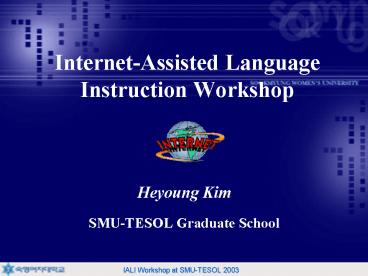InternetAssisted Language Instruction Workshop - PowerPoint PPT Presentation
1 / 16
Title:
InternetAssisted Language Instruction Workshop
Description:
... the-blank, multiple choices,crossword puzzles, games, simulations using advanced ... textbooks' providing linguistic knowledge, such as word lists (or dictionary) ... – PowerPoint PPT presentation
Number of Views:69
Avg rating:3.0/5.0
Title: InternetAssisted Language Instruction Workshop
1
Internet-Assisted Language Instruction Workshop
- Heyoung Kim
- SMU-TESOL Graduate School
2
Goals
- Students understand the functions and uses of
networked multimedia technology from the L2
pedagogical perspective. - Students have an opportunity to utilize a
homepage for the purpose of ESOL instructional
and also personal use.
3
Workshop Schedule
- First week
- Four Types of Web-Based Language Instruction
I - Computer-Mediated Communication (CMC)
- Authentic Text-based instruction (ATBI)
- 2. Second Week
- Four Types of Web-Based Language Instruction
II - Drill and Practice
- Form-Focused Tutorial
4
Workshop Schedule
- 3. Third week
- Teacher Homepage I
- Homepage as Your Portal Site
- 4. Fourth Week
- Teacher Homepage II
- The Power of English Teacher homepage
5
Student Survey
6
Questions
- What are two major functions of the Internet?
- Human-to-Human Communication
- Self-searchable Information
7
OK, it seems fascinating, but I have no idea on
what is in there and how to utilize it--- A
teacher from ESL Internet workshop, 1999---
- What useful resources (or functions) does the
Internet provide for L2 teaching?
2. How can I effectively use these resources
in my class?
8
Four Types of ESL Web Materials
- Computer-Mediated Communication (CMC)
- Authentic Text-Based Information (ATBI)
- Drill and Practice (DP)
- Form-Focused Tutorial (FFT)
9
Workshop Home Address
SMU-TESOL IALI Workshop http//sookmyung.ac.kr/
heyoung/class/IALI
10
Computer-Medicated Communication (CMC)
- By any type of network communication media such
as email, listservs, discussion boards, chat
rooms, instant messengers, educational MOOs etc. - Extends the place and time boundaries
- of the traditional classroom (Shetzer 1998)
11
Computer-Medicated Communication (CMC)
- Makes possible to develop communication skills
between users by one-to-one, one-to-many, or
many-to many communications (Shetzer 1998) - Thus, CMC helps teachers and students to
communicate and collaboratively learn with each
other in and out of class synchronously or
asynchronously.
12
Authentic Text-Based information (ATBI)
- Any Internet websites written in clear and
precise authentic English for various topics and
purposes, such as culture, history,
science,literature, business, etc, which also
gives learners a chance to build any professional
knowledge using English - Enormous quantity of searchable information
appropriate for any aspects of language skill
practices, which gives the comprehensive input to
ESL/EFL learners.
13
Drill and Practice
- Interactive language exercises including
fill-in-the-blank, multiple choices,crossword
puzzles, games, simulations using advanced
network technology etc. - Mostly responsive, visually intriguing,
individualized, possibly updated and added - Considered optimal as out of class or
reinforcing practices.
Computer-based TOEFL test
14
Form-focused Tutorials
- Online textbooks providing linguistic
knowledge, such as word lists (or dictionary),
examples and explanations of grammatical
elements, tutorial guide of academic writings,
etc. - Easily accessible, rich, searchable, and visually
attractive reference with no cost - Help learners to find proper information with
much less time and effort
15
OK, it seems fascinating, but I have no idea on
what is in there and how to utilize it--- A
teacher from ESL Internet workshop, 1999---
- What useful resources (or functions) does the
Internet provide for L2 teaching?
2. How can I effectively use these resources
in my class?
16
2. How can I effectively use these resources in
my class? (pedagogical concerns)
Coincidence with contemporary pedagogical
theory has enhanced the rapid development in
CALL (Hanson-Smith, 1997Ortega,1997)
- Communicative Approach
CLT
CBI
FF
CMC
ATBI
DP
FFT
A Framework of the functions of the Internet from
L2 pedagogical approaches (Kim, 2000)































